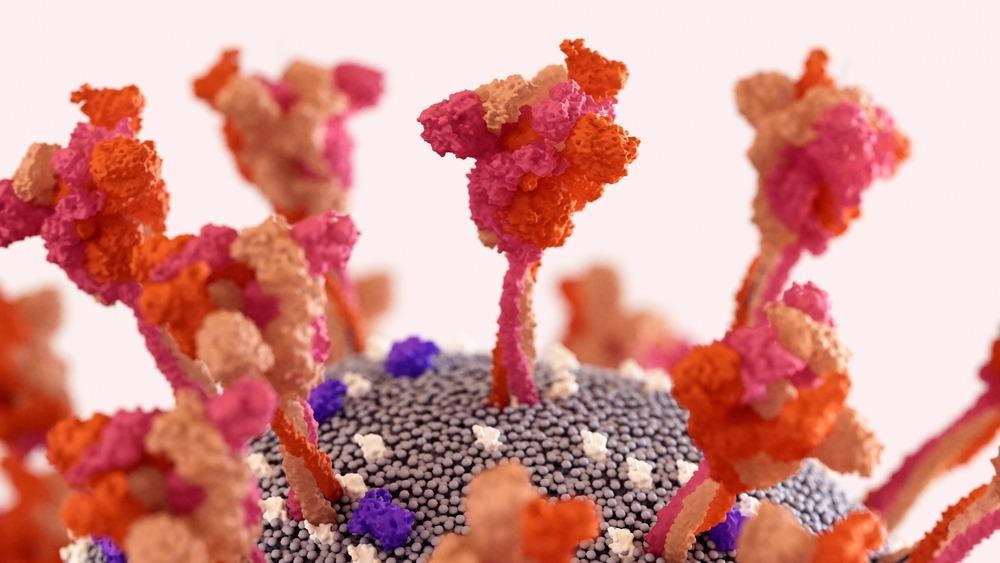Scientists have recently developed electrochemical immunosensors based on graphene oxide−gold (GO−Au) nanocomposites. These immunosensors are highly sensitive with dual function, i.e., they can detect severe acute respiratory syndrome coronavirus 2 (SARS-CoV-2) antigen and antibody. This study is available in the journal ACS Applied Bio Materials.

Study: Highly Sensitive Electrochemical Immunosensor Platforms for Dual Detection of SARS-CoV-2 Antigen and Antibody based on Gold Nanoparticle Functionalized Graphene Oxide Nanocomposites. Image Credit: Design_Cells/Shutterstock.com
Impact of Global Outbreak of Diseases
In the last century, the world has witnessed several global outbreaks that include influenza, severe acute respiratory syndrome coronavirus (SARS-CoV), middle east respiratory syndrome coronavirus (MERS), and most recently, SARS-CoV-2. The ongoing coronavirus disease 2019 (COVID-19) pandemic, caused by SARS-CoV-2, has drastically impacted the global healthcare system and economy. To date, this virus has claimed more than 6.2 million lives and infected around 517 million individuals worldwide.
Scientists worldwide have worked extensively to develop effective preventive measures and sensitive diagnostic tools for fast and accurate detection of the SARS-CoV-2 virus. Early detection of the disease would help prevent further transmission of the virus in the community.
Diagnostic Tools for SARS-CoV-2
Although reverse transcriptase-polymerase chain reaction (RT-PCR) can accurately detect the SARS-CoV-2 virus by identifying viral genomic RNA, it requires expensive setups and highly skilled personnel for its operation. Scientists have stated serological-based methods, e.g., enzyme-linked immunosorbent assay (ELISA), for the detection of SARS-CoV-2 antibodies, are mind-numbing and time-consuming, which restricts their usage for mass testing for COVID-19 antibodies.
Previous studies have reported the development of biosensors, based on field-effect transistor (FET), electrochemical, and fluorescence, to detect COVID-19 disease. Electrochemical biosensors could be extremely advantageous over other biosensors because of their high sensitivity, accuracy, easy operation, and rapid detection processes. Scientists have stated that there is a need to develop superior electrochemical biosensors with greater transducing capabilities, applicability, and high active surface area.
Previous studies have shown that several nanomaterials and nanocomposites, for example, gold nanoparticles (AuNPs), graphene oxide (GO), and reduced graphene oxide (RGO), are promising constituents for novel electrochemical biosensors.
Development of Highly Sensitive Electrochemical Immunosensor for SARS-CoV-2: A New Study
Scientists have synthesized GO−Au nanocomposites to fabricate two immunosensors used to detect SARS-CoV-2 antigen and antibody. The newly developed GO−Au nanocomposites possess high conductivity, a large surface to area ratio, and several functional groups for their binding with biomolecules.
The authors have characterized the newly synthesized nanocomposites using UV−Vis spectroscopy, transmission electron microscopy (TEM), and X-ray diffraction (XRD). The average particle size of the AuNPs in the nanocomposite was measured to be 12.1 nm. UV-Vis analysis revealed the presence of characteristic peaks of GO (265 nm) and Au (538 nm) in the synthesized GO-Au nanocomposite. Interestingly, XRD analysis showed a peak at 26.4°, which implied a partial reduction of GO in the nanocomposite. TEM image indicated a uniform dispersion of AuNPs in the nanocomposite as well as its polycrystalline nature.
The electrochemical activity of GO-Au nanocomposite and fabricated immunosensors were analyzed through differential pulse voltammetry (DPV), cyclic voltammetry (CV), and electrochemical impedance spectroscopy (EIS) techniques. Scientists performed all electrochemical measurements in redox electrolytes.
CV helped determine SARS-CoV-2 antibody−antigen interaction on electrode surfaces. Both CV and DPV results revealed effective fabrication of the SARS-CoV-2 antibody immunosensor.
In this study, researchers reported that the SARS-CoV-2 antigen immunosensor exhibited excellent sensitivity with a linear detection range between 10.0 ag mL–1 and 50.0 ng mL–1. They further estimated the detection range of antibody immunosensor to be between 1.0 fg mL–1 and 1.0 ng mL–1. For the SARS-CoV-2 antibody immunosensor, the limit of detection (LOD) was measured to be 1 fg mL−1. Similarly, the LOD of the SARS-CoV-2 antigen immunosensor was estimated to be 3.99 ag mL−1.
Synthetic samples were used initially to analyze both the immunosensors and the results were later validated using serum and nasopharyngeal swab samples of COVID-19 patients. They obtained samples from nine different COVID-19 patients to validate their findings. Both DPV analysis and voltammetric characterization showed that the SARS-CoV-2 antibody immunosensor and SARS-CoV-2 antigen immunosensor could be effectively utilized to study clinical samples.
To further determine the sensitivity of the immunosensors, scientists used nasopharyngeal samples of seven different patients (four SARS-CoV-2 negatives and three positives). The results obtained in this study were consistent with the RT-PCR test.
Conclusion
In this study, the authors developed electrochemical immunosensor platforms based on newly developed GO−Au nanocomposites. These immunosensors have a dual function, i.e., detection of both SARS-CoV-2 antibodies as well as antigen. In the future, these immunosensors could be used to develop portable point of contact (POC) devices for accurate detection of the SARS-CoV-2 virus.
Reference
Sadique, A.M. et al. (2022) Highly Sensitive Electrochemical Immunosensor Platforms for Dual Detection of SARS-CoV-2 Antigen and Antibody based on Gold Nanoparticle Functionalized Graphene Oxide Nanocomposites. ACS Applied Bio Materials. https://doi.org/10.1021/acsabm.2c00301
Disclaimer: The views expressed here are those of the author expressed in their private capacity and do not necessarily represent the views of AZoM.com Limited T/A AZoNetwork the owner and operator of this website. This disclaimer forms part of the Terms and conditions of use of this website.